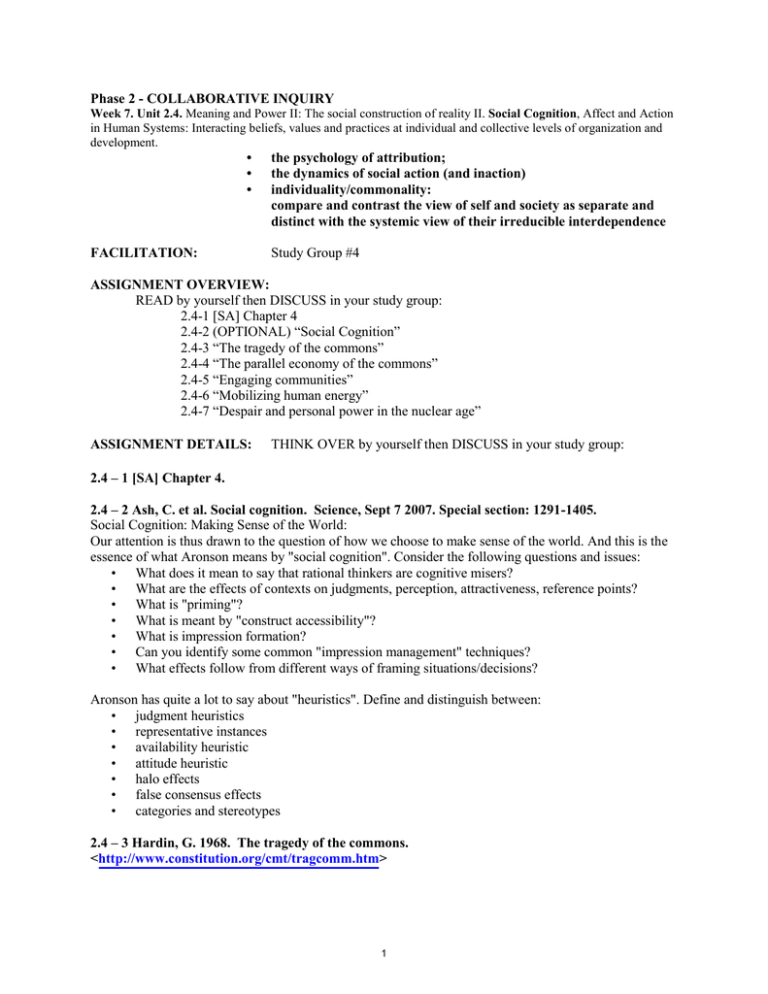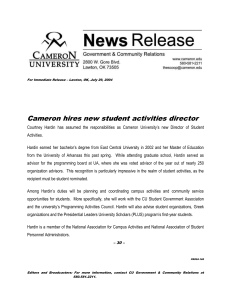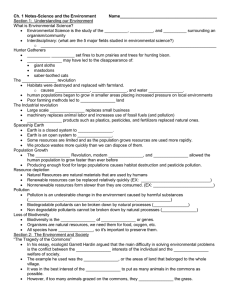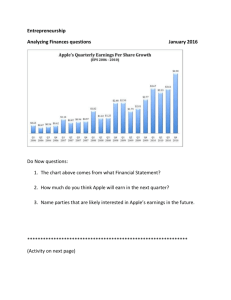Phase 2 - COLLABORATIVE INQUIRY
advertisement

Phase 2 - COLLABORATIVE INQUIRY Week 7. Unit 2.4. Meaning and Power II: The social construction of reality II. Social Cognition, Affect and Action in Human Systems: Interacting beliefs, values and practices at individual and collective levels of organization and development. • • • FACILITATION: the psychology of attribution; the dynamics of social action (and inaction) individuality/commonality: compare and contrast the view of self and society as separate and distinct with the systemic view of their irreducible interdependence Study Group #4 ASSIGNMENT OVERVIEW: READ by yourself then DISCUSS in your study group: 2.4-1 [SA] Chapter 4 2.4-2 (OPTIONAL) “Social Cognition” 2.4-3 “The tragedy of the commons” 2.4-4 “The parallel economy of the commons” 2.4-5 “Engaging communities” 2.4-6 “Mobilizing human energy” 2.4-7 “Despair and personal power in the nuclear age” ASSIGNMENT DETAILS: THINK OVER by yourself then DISCUSS in your study group: 2.4 – 1 [SA] Chapter 4. 2.4 – 2 Ash, C. et al. Social cognition. Science, Sept 7 2007. Special section: 1291-1405. Social Cognition: Making Sense of the World: Our attention is thus drawn to the question of how we choose to make sense of the world. And this is the essence of what Aronson means by "social cognition". Consider the following questions and issues: • What does it mean to say that rational thinkers are cognitive misers? • What are the effects of contexts on judgments, perception, attractiveness, reference points? • What is "priming"? • What is meant by "construct accessibility"? • What is impression formation? • Can you identify some common "impression management" techniques? • What effects follow from different ways of framing situations/decisions? Aronson has quite a lot to say about "heuristics". Define and distinguish between: • judgment heuristics • representative instances • availability heuristic • attitude heuristic • halo effects • false consensus effects • categories and stereotypes 2.4 – 3 Hardin, G. 1968. The tragedy of the commons. <http://www.constitution.org/cmt/tragcomm.htm> 1 What is self-interest? What is social responsibility? These questions arose with particular poignancy last week. Hardin’s classic article has nothing to say about corporations as such, but it poses some essential questions about relations between self and society. Hardin identifies self-interest with a version of "human nature" that is irremediably riddled with the kind of selfishness and greed that ensures that people must continue to behave as we presently observe them to behave (and that's that!). Arguably, the choice of herdsmen (as one of the first occupations humans have taken) is rather inappropriate to illustrate a behavior that is characteristic of less ancient cultural patterns; however, the contemporary idea of "maximizing personal (or corporate) self-interest” is particularly typical for the current economy of cut-throat competition in pursuit of profit. Without doubt, this relation between self-interest and selfishness presents a major conflict and may readily lead one to feel a sense of abject despair for the human condition; this is particularly true when the "tragedy" is framed – as it is by Hardin -- in the customary dualist (either/or) mode. Under these conditions the two ethical alternatives that offer themselves are either utilitarianism or deontology. In other words, one will either accept the necessity of behaving selfishly (because that is an inevitable consequence of pursuing and maximizing one’s utility) or will adopt a "disinterested moral obligation" regardless of self-interest (which is the definition of deontology). However, from the systemic perspective this counter-position of self versus common interest can be seen as an omnipresent dialectic--one that expresses and embodies the tension that follows upon a realization that the existence and integrity of the individual system depends on its belonging to and interrelatedness with more inclusive systems. Does this tension imply that individual and common (or communal) interests are mutually exclusive and irreconcilable? Or do the systemic interrelations necessarily entail an interconnectedness of interests? Can giving and taking be conceived of as complementary processes in eco-systemic interaction of individuals with each other and with the surrounding environment (social and natural)? Transformed, (we will argue) the relationship can become “win-win”. 2.4 – 4 Rowe, J. “The parallel economy of the commons.” State of the world 2008. Worldwatch Institute: 138-150. 2.4 – 5 Assadourian, E. “Engaging communities.” State of the world 2008. Worldwatch Institute: 151-165. 2.4 – 6 Calder J.S. “Mobilizing Human Energy.” State of the world 2008. Worldwatch Institute: 166-179. Crowe and Rowe take a different view of our predicament from Hardin’s. Meanwhile, Assadourian and Calder envision conditions in a world where the interests of the individual and the interest of the community are more harmonious and where personal rights and social responsibilities are anything but irreconcilable and mutually contradictory. Here is a credible hypothesis: our cognitive capacity to reason clearly and our behavioral capacity to act effectively are impaired by our affective response to so much "bad news". Indeed, this is precisely the thesis presented by Joanna Rogers Macy in the following selection: 2.4 –7 Macy, J.R. 1983. Despair and personal power in the nuclear age. This important book, now sadly out of print, was written in 1983, in the midst of an escalating nuclear arms race between the US and USSR. It was a terrifying time quite widely, and Macy used the pervasive fear of nuclear annihilation to show precisely how our "feelings for the world" condition and constrain 2 how we deal (or fail to deal) with information about world events -- particularly when the news carries with it an unwelcome threat to our personal sense of security. Macy is a keen social psychologist who understands a lot about human mental life and behavior. And her explanation of "the dynamics of inaction" in the face of nuclear Armageddon has the ring of truth to it. Without doubt, conditions prevailing today are different than they then were. But precisely because we are still pained and terrified by events occurring in our world so Macy’s 1983 thesis still resonates almost a generation later. To some it is full of still-contemporary relevance and timeless wisdom. What is your view? Facing today's images of actual and possible human disasters, how do we feel? Do those feelings affect our behavior? Do you see Macy's diagnoses and prescriptions as still generally true and relevant for you in the light of current events? If so, how? If not, why not? Compare and contrast her perspective with those of Rowe, Assadourian, and Calder (below). Here's a bit more data: In any given situation, people will generally behave in accordance with their understanding of the situation in which they happen to be. We all carry around in our heads information about our own social roles therein. Are you aware of yourself as a person moving through various social contexts in the course of (say) a day; do you find yourself affected by your surroundings and acting differently in different situations? In what respects are you aware of adopting different "personas" and playing different roles in different situations? Give some examples. Is it possible to play so many different roles and still remain "yourself"? If all of your "personas" were to gather together in one place and time, how many of them would there be? And if they proceeded to discuss the kind of person you really are, what would they say? Would they all agree in their assessments of your basic attitudes? inclinations? skills? your sense of self awareness of your place in your surroundings and understanding of yourself, your sense of justice; your wisdom and your knowledge of "how the world works? What would they be likely to say about you? A Note on Aronson's first law: Perhaps one reason we equate what we observe about other people’s behavior to their underlying personality traits is that when faced with a limited set of data relating to other people, we have a tendency to generalize in accordance with our own sets of stereotypes and only have limited opportunities to observe them in but a few contexts or situations (e.g. teammate, classmate or teacher). Consider your own behavior. Define “human nature”. Describe and discuss "the self-fulfilling prophesy” How do social outcomes relate to social expectations? What is meant by "reconstructive memory"? How does this relate to the questionable validity of "memories recovered from childhood"? to the unreliability of eye witness testimony? Define "confirmation bias", "hindsight bias", "actor-observer bias", "self bias", "self-serving bias". Professed attitudes (as measured e.g. by responses to questionnaires) are neither highly predictive of nor highly correlated with respondents’ observed behavior in the relevant situation(s). Explain. 3 What is "the fundamental attribution error"? Explaining something (away) as “human nature” is an instance of the fundamental attribution error. (True or False?) Explain. What is "cognitive dissonance?" There are other ways of committing the ultimate attribution error (attributing things or events to God’s will and/or nature’s intentions, fated genes, etc.), but when it comes to taking the cake for achieving the epitome in simplistic mechanistic reductionistic “explanations” it is hard to beat the perennial favorite (normally said in a tone of definite finality and with an air of enlightened resignation in the face of irrefragible fact that “you can’t change human nature”. As if to say: “Yes. It really is awful. But what do you expect? This kind of thing may be humanly repulsive to the romantically inclined. But the hard fact of life is that it remains statistically normal. And, anyway, given the inherently flawed (sinful?) nature of human nature, it is bound to be repeated in multifarious variants from time to time and place to place as long as flawed people can so easily gain access to weapons of mass destruction." 4 MIT OpenCourseWare http://ocw.mit.edu 9.70 Social Psychology Spring 2013 For information about citing these materials or our Terms of Use, visit: http://ocw.mit.edu/terms.




